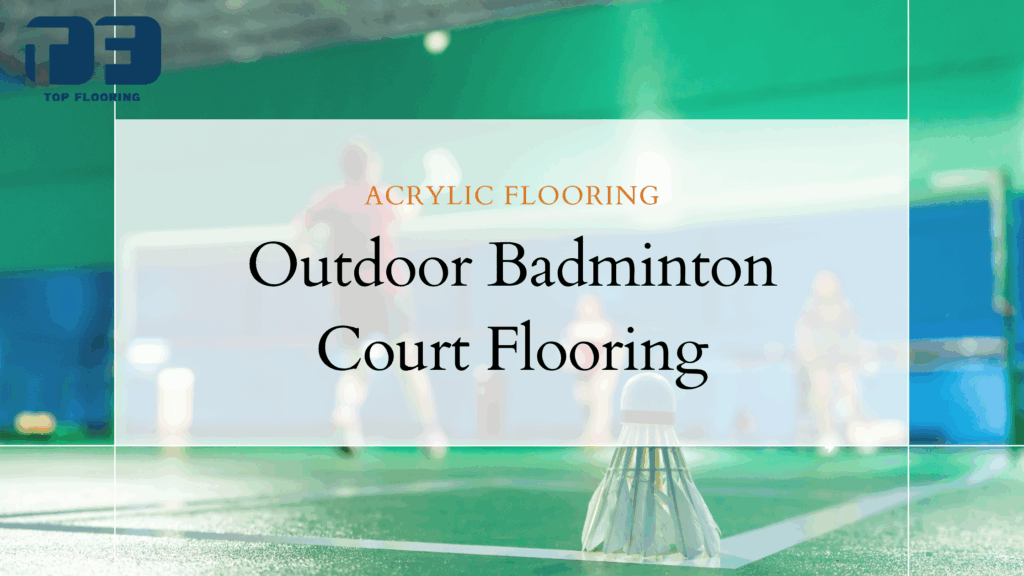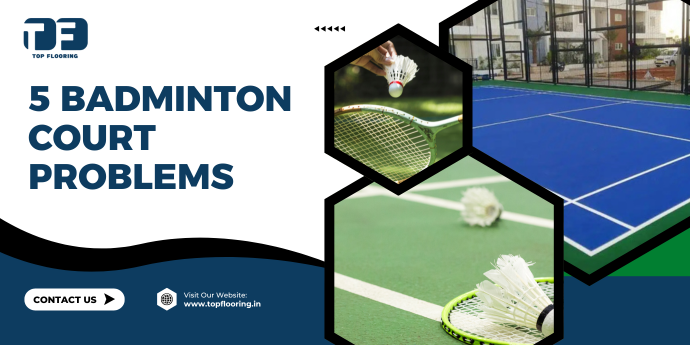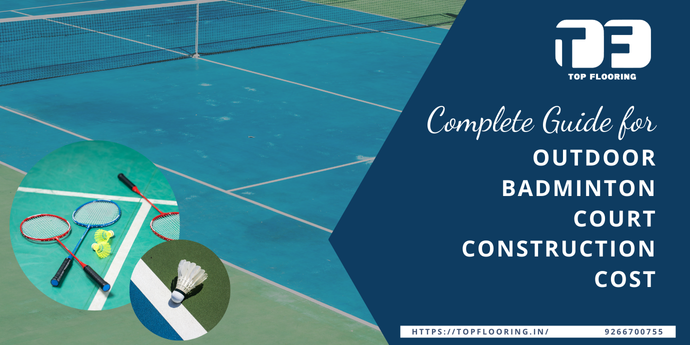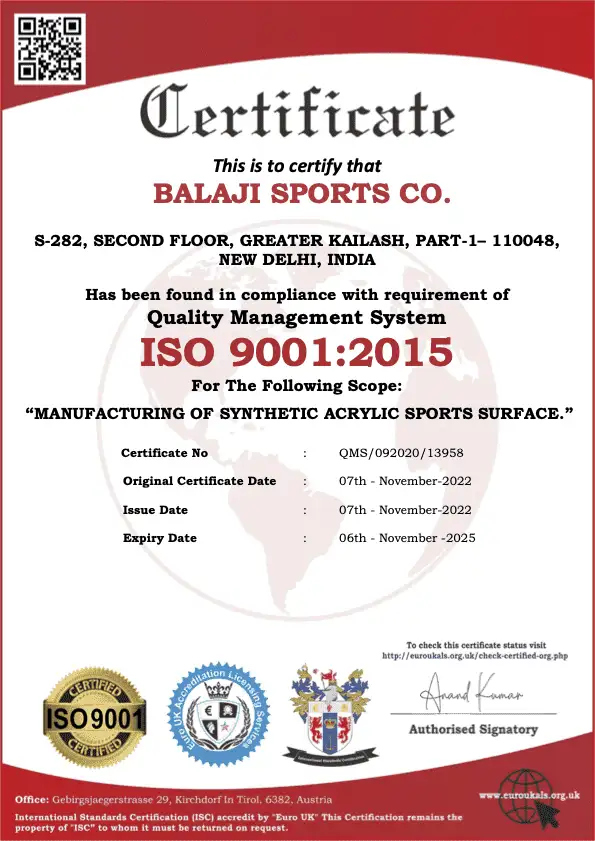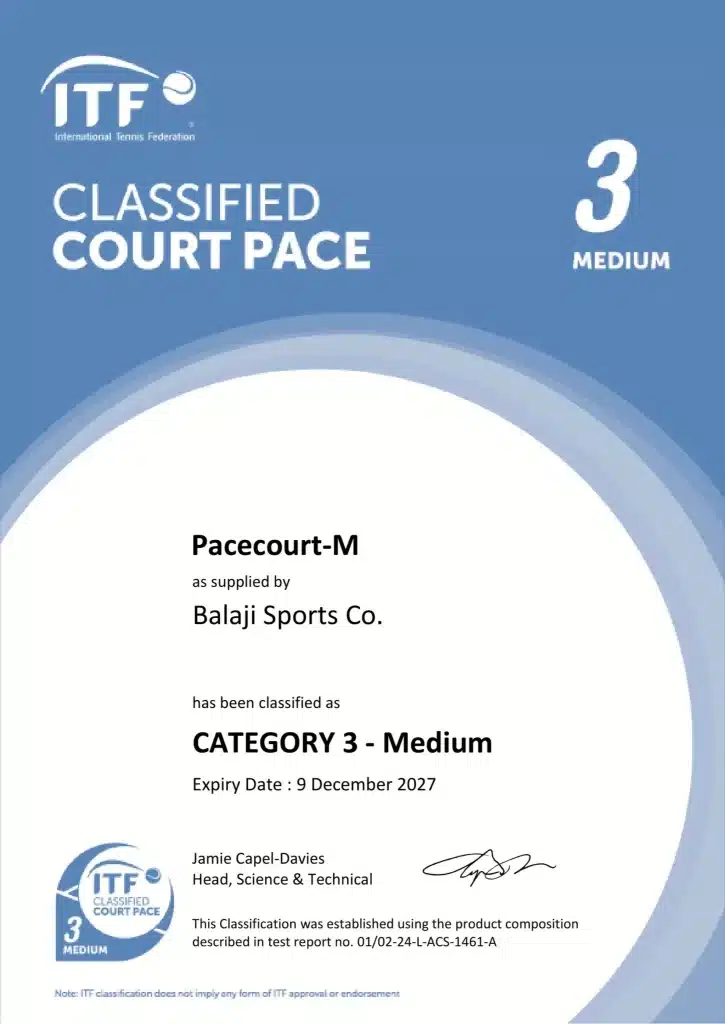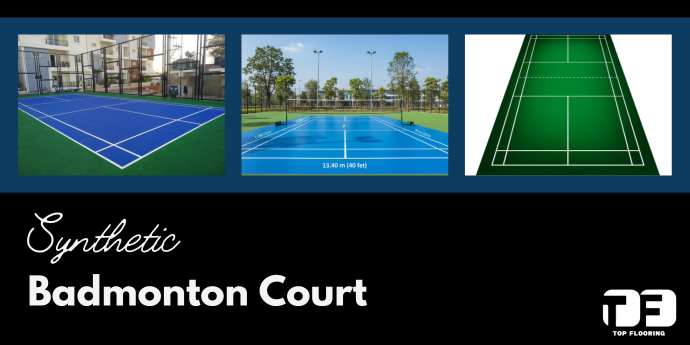
Badminton has become one of the fastest growing sports in India, played in schools, housing societies, sports academies and professional clubs. With the increasing popularity of the game, there is a growing demand for durable and high performance synthetic badminton court flooring. Traditional wooden or cement based surfaces no longer meet the expectations of modern players as they often lead to injuries, uneven bounce and high maintenance.
Traditional wooden or cement courts that once seemed “good enough” are no longer keeping up with the expectations of modern players. They wear out too soon, demand frequent maintenance and in many cases even increase the risk of injury.
This is where synthetic badminton court flooring stands out. Known for its durability, slip resistance and cost effectiveness, synthetic flooring has become the preferred choice for badminton courts in India.
Badminton Court Flooring Options in India
Let’s take a look at the flooring types commonly used in India and see how they compare.
1. Wooden Flooring
For decades, wooden floors were considered the premium option for badminton courts. They offered a polished look, decent bounce and were often used in indoor facilities. But in India, wood has a big drawback: climate sensitivity.
- In humid or monsoon prone regions, wooden floors tend to warp, swell or crack.
- They require constant polishing and maintenance, which adds to the cost.
- Even a small leak or moisture build up can damage the surface permanently.
So while wooden courts still exist in some older facilities, they are slowly being replaced because they just don’t suit India’s unpredictable weather.
2. PVC/PU Mats
PVC and PU mats became popular because they are easy to install and seem budget friendly at first. Many schools and small clubs chose them as a quick flooring solution.
But the problem is longevity:
- These mats wear out within a few years of regular play.
- They can lose grip, causing slips and uneven bounce.
- Frequent replacements make them expensive in the long run.
They’re good for temporary setups or small practice spaces but not for facilities that want a professional, long lasting court.
3. Cement/Concrete Courts
This is the most common type of badminton court in India, especially in housing societies and community clubs, because it’s cheap and easy to build. But when it comes to safety and performance, cement courts fall short.
- They are hard and unforgiving, leading to knee and ankle injuries.
- The bounce is uneven, which affects the game.
- No shock absorption means long games can be painful and tiring.
In short, cement may save money upfront but ends up costing more in injuries, discomfort and poor playing experience.
4. Synthetic Acrylic Flooring
Now we come to the real game-changer: synthetic sports flooring. This is the new standard for badminton courts in India.
Here’s why synthetic flooring stands out:
- Weather-resistant: Handles humidity, heat and rain without warping or cracking.
- Durable: Lasts 8–10 years with minimal maintenance.
- Safe: Cushion layers absorb shock and reduce injury risk.
- Professional Play: Provides consistent shuttle bounce and grip, trusted by academies and international-level facilities.
- Low Maintenance: Easy to clean and resurface compared to wooden or PVC floors.
In India where climate and usage varies so much, synthetic acrylic flooring provides the perfect balance of safety, performance and cost.
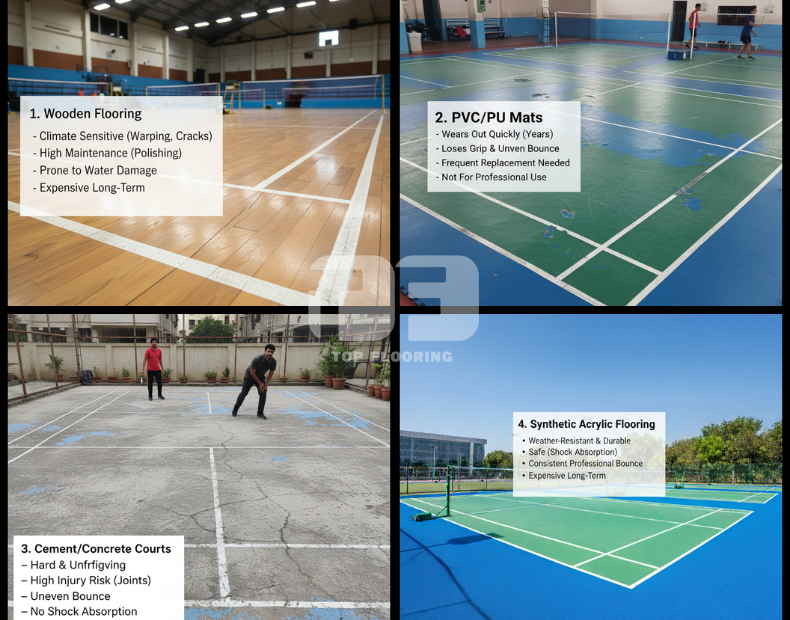
Key Benefits of Synthetic Badminton Flooring
Durability in Indian Climate
One of the biggest advantages of synthetic badminton flooring is its ability to handle Indian weather. Whether its scorching heat of summer, heavy humidity of monsoons or cooler winters, synthetic flooring remains the same. Unlike wooden floors which warp, swell or crack when exposed to moisture, synthetic courts remain stable and reliable throughout the year. This makes them a long term solution for schools, societies and sports academies that want consistent playability in all seasons.
Player Safety and Comfort
A good court should protect the player as much as it enhances performance. Synthetic flooring is designed with a slip resistant surface that reduces the chances of sudden falls or accidents. Beneath the surface, cushion layers absorb shock which takes pressure off the knees, ankles and joints – a critical factor for players who practice for long hours. The added comfort encourages both beginners and professionals to train harder without fear of injuries or fatigue from a harsh playing surface.
Consistent Ball Bounce & Grip
For badminton players, consistency is key. Synthetic courts are designed with uniform surface texture that ensures predictable shuttle response during rallies. This consistency allows players to develop their skills without worrying about irregular bounce or slippery spots that disrupt their game. The flooring also maintains excellent grip giving athletes better control and quick footwork across different styles of play. Whether it’s a school level tournament or professional coaching, synthetic badminton courts provide a reliable playing experience.
Low Maintenance
Unlike wooden floors that need frequent polishing or PVC mats that need to be replaced early, synthetic badminton flooring is very low maintenance. A simple mop or sweep is enough to keep the surface clean. The material is built to last, reducing the need for costly repairs. And when resurfacing is required, the process is quick, affordable and efficient so minimal downtime for the facility. This is the smart choice for organizations that want quality without maintenance headaches.
Customizable Court System
Every facility is unique, and synthetic badminton flooring can match those needs. Available in 5-layer, 6-layer, 8-layer and 9-layer systems, the flooring can be tailored to the level of play and budget. Cushion coats, color finishes and line markings can be applied to meet BWF (Badminton World Federation) standards, so the court is tournament ready. Whether it’s an indoor academy, an outdoor housing society court or a professional sports complex, synthetic acrylic flooring can be customized to give the right balance of performance and durability.
Cost Effective Badminton Court in the Long Run
At first glance many decision makers see synthetic badminton court flooring as slightly more expensive than options like PVC mats or concrete surfaces. But here’s the truth: synthetic flooring pays for itself over time.
- Long Life Cycle (8–10 years): Unlike PVC mats that wear out in 2–3 years or wooden floors that need heavy maintenance, synthetic courts last for nearly a decade with proper care. That means fewer replacements and less hassle.
- Lower Repair and Resurfacing Costs: Wooden floors need regular polishing and PVC mats often need full replacements, but synthetic flooring can be resurfaced at a fraction of the cost.
- Professional Value Addition: For schools, academies and sports clubs, a synthetic badminton court is not just a play area – it’s an investment in reputation. Players prefer facilities with modern, professional standard surfaces which helps in attracting memberships, coaching enrollments and tournaments.
In short, synthetic flooring is more than a surface – it’s a long term investment that ensures durability, player safety and cost savings.
Installation Process of Synthetic Badminton Flooring
Building a world class badminton court doesn’t happen overnight. It’s a step by step process that ensures both performance and durability. Here’s how Top Flooring designs its courts:
- Base Preparation – A strong base of asphalt or concrete is laid, with a proper slope for drainage. This foundation is critical to the court’s lifespan.
- Concrete Primer – If the base is concrete, a primer is applied to ensure strong bonding. (Asphalt bases don’t need primer.)
- Acrylic Resurfacer – This layer smooths out the surface, fills in small imperfections and prepares it for the cushion system.
- Cushion Coats – Multiple cushioned layers are applied for shock absorption and comfort during long matches.
- Color Coats – Bright, UV resistant coatings to bring the court to life and long lasting performance under the sun.
- Silica Sand & Texture – Textured layer with silica sand for slip resistance and perfect grip for quick movements.
- Line Marking – Lines are marked as per BWF (Badminton World Federation) dimensions: 13.4 m × 6.1 m so the court is ready for training and tournaments.
Every layer is designed to work together – from base to finish – so the court performs consistently in every rally, every season.
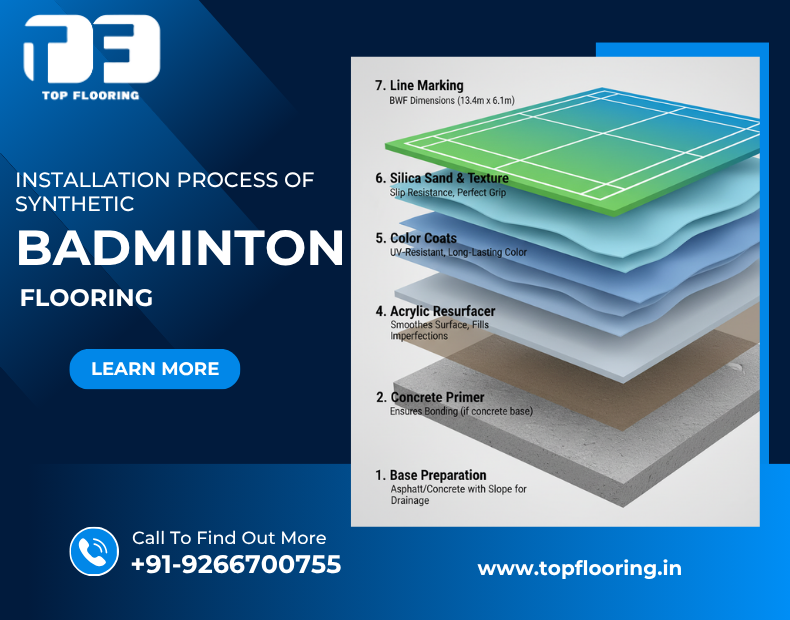
Standards & Certifications to Look For Badminton Court
Not all badminton courts are built equal. To make sure your investment lasts, always look for global standards and certifications before choosing flooring materials.
- BWF-Approved Dimensions & Markings: Ensures the court is compliant for both practice and competition.
- ITF/ISO-Certified Acrylic Materials: Guarantees that the flooring meets international benchmarks for safety, durability and performance.
- Compliance with Safety Guidelines: A court should not only look good but also protect players from slips, injuries and surface irregularities.
At Top Flooring, every badminton court material supplied is tested, certified and optimized for Indian conditions—from scorching summers to heavy monsoons. That’s why our courts are trusted by schools, sports clubs and academies across the country.
Synthetic Flooring vs Other Flooring Options in India
When choosing a badminton court surface, you need to look at how different options compare. Each material has its pros and cons, but synthetic flooring clearly outshines the rest when it comes to long term performance in India.
Synthetic vs Wooden Courts
Wooden courts once carried a sense of prestige, especially in indoor facilities. But in India’s humid and monsoon-prone climate, wooden floors quickly lose their charm. They are highly climate sensitive, prone to warping, swelling or cracking and need constant polishing and maintenance.
In contrast, synthetic courts are designed to withstand humidity and temperature fluctuations. They maintain their form and playability year round with minimal maintenance costs, making them far more practical for Indian conditions.
Synthetic vs PVC/PU Mats
PVC and PU mats are chosen because they are quick to install and seem budget friendly. The problem is their short lifespan—regular play wears them out within just a few years and replacements become costly. Players also complain of reduced grip and uneven bounce as the mats age.
On the other hand, synthetic badminton courts last for 8-10 years, offering consistent grip, bounce and safety throughout. While the initial investment may be slightly higher, synthetic flooring is more cost effective in the long run.
Synthetic vs Cement/Concrete Courts
Cement and concrete courts are common in housing complexes and small clubs because of their low cost. But from a player’s perspective, they are far from ideal. These surfaces are too hard and unforgiving, players get injured frequently, especially knee and ankle problems. The bounce is inconsistent and overall playing experience is poor.
Synthetic flooring solves these issues by providing shock absorption, slip resistance and player comfort. Even in community or society setups, a synthetic court makes badminton from a casual activity to a safe and enjoyable sport for all ages.
Real-World Applications of Badminton Courts in India
One of the biggest reasons synthetic flooring has taken off is its flexibility. It fits in all types of facilities, from grass root training centers to international standard complexes.
- Schools & Colleges – Students need safe and reliable courts to practice and compete. Synthetic flooring provides grip, comfort and durability so children can focus on improving their game without worrying about injuries.
- Housing Societies & Townships – As badminton grows as a recreational sport, many societies are opting for synthetic courts in their sports zones. They are durable, low maintenance and for casual play for families and residents.
- Sports Academies & Coaching Centers – For serious training, consistency is key. Synthetic acrylic courts ensure uniform bounce, professional grip and reduced injury risk, that’s why they are the first choice for academies across India.
- Government & Private Projects – Synthetic flooring is now being widely used in stadiums, sports complexes and large scale infrastructure projects. Its durability and compliance with international standards makes it suitable for both recreational and professional use.
From the bustling metros like Delhi, Mumbai and Bangalore to fast growing tier 2 and tier 3 cities, synthetic badminton court flooring is making the game more accessible, safe and enjoyable for millions of players across India.
Conclusion
Badminton is no longer just a recreational activity – it’s a growing professional sport in India. To meet the demands of players and facilities synthetic badminton court flooring is the solution. With its durability, safety, performance and cost effectiveness it’s the clear choice over wooden, PVC or cement. At Top Flooring, we provide world class synthetic acrylic flooring materials designed for Indian conditions and built to last. Whether it’s for schools, societies or professional academies our flooring systems ensure the best playing experience for every level of badminton.

